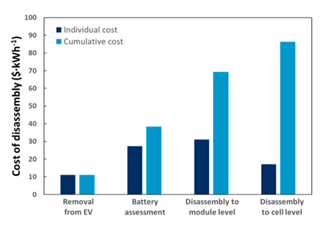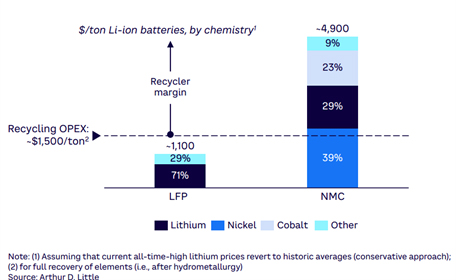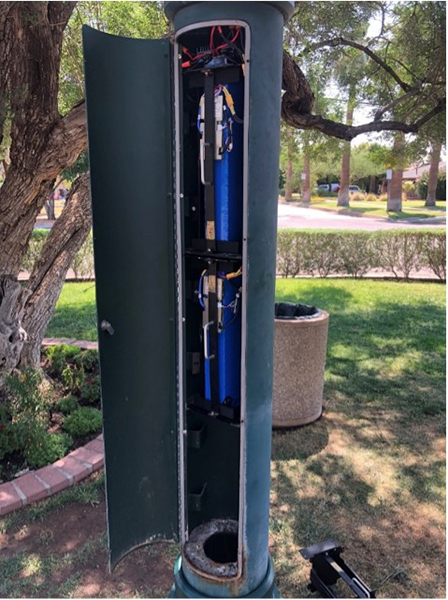By officially approving a vendor of repurposed lithium batteries, the City of Phoenix is building trust in the second-life BESS.
“Repurposed batteries are a perfect solution [for battery storage systems], cutting costs and contributing to the sustainability and our circular economy goals,” says Amanda Jordan, Circular Economy project manager for the City of Phoenix.
Lithium batteries are enabling the global energy transition to electricity in many industries and are experiencing explosive growth in demand across various applications and geographies. As multiple gigawatt-hour factories launched in the last few years start to deliver new batteries at scale, a second-life battery economy emerged and is dynamically growing.
The lower price of a repurposed lithium battery pack comes with high sustainability benefits of avoiding emissions from the energy required to produce new batteries, delayed recycling, and diverted waste. The key challenge to repurposing batteries lies in trust – in absence of a mandatory digital battery passport, there is a lack of transparency into the first-life application of non-new batteries.
By officially approving a vendor of battery storage systems running on repurposed lithium batteries, the City of Phoenix is building trust in the second-life battery energy storage. The success of this project laid the foundation for scaling of battery repurposing in electrification projects by other departments and municipalities.
A significant rise in the production of lithium-ion batteries for electric vehicles, power storage for renewable energy generation at utility scale, and multiple other uses, home and community solar, power tools and electric mobility, formed a large and dynamically growing second-life battery market. Unlike earlier generations of batteries, lithium cells and packs have a much longer useful life and change their performance over their life cycle. The drive for sustainable use of resources, the economic requirement to maximize the utilization of equipment, and abundance of batteries suitable for second-life applications created a new second-life battery market with multiple business opportunities, supported by experts in battery repurposing and recycling, such as Bluewater Battery Logistics.
Indeed, it takes years of expertise in diverse batteries applications to navigate nuanced requirements for battery performance and capabilities of battery packs of different chemistry composition, state-of-health, capacity, etc.

It is always a good idea to think about reusing batteries before recycling, but a good business foundation is non-negotiable. Repurposed batteries must not cost more than new ones. In fact, they need to be cheaper by at least 30-40%. Having an overseas partner with lower labor costs can make or break the deal in some cases.

Another important calculation in repurposing vs. recycling is the price of black mass and recovered materials, and the cost of extraction. For example, LFP batteries provide less output of valuable metals, compared to NMC. In fact they have negative recycling value, which meand you have to pay to recyle them. Which drives the value of repurposing end-of-life LFP cells (with at least 60% SOH), and prolonging their usefule life for as long as possible. The value of recovered materials from NMC cells recycling can in some cases be greater than resale value for new applications.
However, the greatest challenge in the second-life battery economy is the lack of transparency and standards. This new market requires seller validation and new trust mechanisms to reduce the cost of testing and re-certifying of cells and provide a seamless flow of batteries from one application to another.
The Office of Environmental Programs at City of Phoenix has developed the Sustainable Purchasing Policy to promote purchasing products and services that have a reduced impact on human health and the environment when compared to competing products or services that serve the same purpose, while remaining fiscally responsible (starting with traditional factors, such as product price and performance).
As one of the fastest growing cities in the nation, Phoenix’s demand for resources, such as water and energy, is expected to grow considerably in the years to come. A sustainable purchasing policy allows procurement of more sustainable products that have a reduced impact on the environment and are either made from recycled products or can easily be recycled at the end of the useful life. Through these actions, the city moves closer to meeting its 2050 Sustainability Goals, while also supporting a city-wide culture of sustainability.
Bluewater Battery Logistics helps battery OEMS and users to repurpose and recycle lithium forklift batteries. After testing and evaluation of the batteries end-of-life cells are sent for hydrometallurgical recycling. Cells with at least 60% SOH (more often, EV batteries are retired after they drop below 80% SOH) find new applications.
“Bluewater Battery evaluates a few variables to find the optimum way to repurpose the batteries for a second life and minimize the environmental impact,” explains Steve Feinberg, CEO at Bluewater. “We look at the condition of the cells, geographical location for minimal shipping, and our partners’ expertise to repurpose batteries.” The batteries’ new lives in secondary applications depend on how they fare in tests of voltage, Ah capacity, and various state of health (SOH) parameters.

The story of one 80V 360Ah LFP forklift battery began in a Hyster E55XN Class I sit-down lift truck, operating in a packaging facility of a fruit-producing company in the state of Washington, USA.
Our demo battery came back with many years of life left in each cell, but with no chance to be used in a new forklift battery again.
Fortunately, Bluewater found a second-life application in the solar array battery storage, a part of the pilot project of the City of Phoenix. “Repurposed batteries are a perfect solution [for battery storage systems], cutting costs and contributing to the sustainability and our circular economy goals,” says Amanda Jordan, Circular Economy project manager for the City of Phoenix.
Jordan’s team has successfully completed a pilot project to use remanufactured lithium batteries for solar panel energy storage to power lighting in South Mountain Park in summer of 2024. The major concern has always been the batteries’ resistance to Arizona heat but the LFP lithium cells in energy storage for a solar array demonstrated adequate resilience and are expected to work reliably for another 10 years. “The positive outcome of this project has paved the road to the mass usage of second-life lithium cells as energy storage for the renewables (in Arizona),” Amanda commented.
Repurposed batteries help achieve one of the Circular Economy Projects’ KPIs – waste reduction. “This is a good example of a secondary stream of waste diverted from landfill, and is also a cost saving mechanism, contributing to our sustainability goals” said Phoenix Chief Sustainability officer Mark Hartman.
A city’s vendor database is a public record, it is also a network for other city managers, providing information on available and tested sustainable solutions, which are also cost effective.
The total of 80 kWh of battery energy storage was deployed in 5 locations, including 4 solar sites and one emergency power back-up. 1.9 tons of CO2E was saved by solar generation (compared to Arizona grid average emissions), and 13.5 tons CO2E were avoided from manufacturing of replaced new batteries.
What is much more important is that the business case for second-life battery application was proven, and a verified vendor of repurposed batteries is endorsed by the City of Phoenix, based on the validity of the results and feedback from the users.

Energy transition, which plays a vital part in fighting climate change, is enabled in many ways by lithium battery technology. Repurposing lithium cells at the end of their useful life from their first-life application to less-demanding second-life does not just divert gigantic amounts of waste. Dynamic second-life battery market fuels the creation of new businesses and reduces the price of solar energy ++for small rural solar plants, community solar network, and to MWh commercial and industrial sites installations, further accelerating the adoption of renewables.
In this episode, I sat down with Beejan Giga, Director | Partner and Caleb Emerson, Senior Results Manager at Carpedia International. We discussed the insights behind their recent Industry Today article, “Thinking Three Moves Ahead” and together we explored how manufacturers can plan more strategically, align with their suppliers, and build the operational discipline needed to support intentional, sustainable growth. It was a conversation packed with practical perspectives on navigating a fast-changing industry landscape.